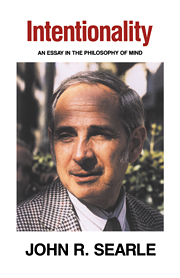Book contents
- Frontmatter
- Contents
- Acknowledgements
- Introduction
- 1 The nature of Intentional states
- 2 The Intentionality of perception
- 3 Intention and action
- 4 Intentional causation
- 5 The Background
- 6 Meaning
- 7 Intensional reports of Intentional states and speech acts
- 8 Are meanings in the head?
- 9 Proper names and Intentionality
- 10 Epilogue: Intentionality and the brain
- Subject index
- Name index
- Frontmatter
- Contents
- Acknowledgements
- Introduction
- 1 The nature of Intentional states
- 2 The Intentionality of perception
- 3 Intention and action
- 4 Intentional causation
- 5 The Background
- 6 Meaning
- 7 Intensional reports of Intentional states and speech acts
- 8 Are meanings in the head?
- 9 Proper names and Intentionality
- 10 Epilogue: Intentionality and the brain
- Subject index
- Name index
Summary
The primary aim of this book is to develop a theory of Intentionality. I hesitate to call it a general theory because a large number of topics, e.g., the emotions, are left undiscussed, but I do believe the approach here presented will prove useful for explaining Intentional phenomena generally.
This book is the third in a series of related studies of mind and language. One of its objectives is to provide a foundation for my two earlier books, Speech Acts (Cambridge University Press, 1969) and Expression and Meaning (Cambridge University Press, 1979), as well as for future investigations of these topics. A basic assumption behind my approach to problems of language is that the philosophy of language is a branch of the philosophy of mind. The capacity of speech acts to represent objects and states of affairs in the world is an extension of the more biologically fundamental capacities of the mind (or brain) to relate the organism to the world by way of such mental states as belief and desire, and especially through action and perception. Since speech acts are a type of human action, and since the capacity of speech to represent objects and states of affairs is part of a more general capacity of the mind to relate the organism to the world, any complete account of speech and language requires an account of how the mind/brain relates the organism to reality.
- Type
- Chapter
- Information
- IntentionalityAn Essay in the Philosophy of Mind, pp. vii - xPublisher: Cambridge University PressPrint publication year: 1983
- 1
- Cited by



